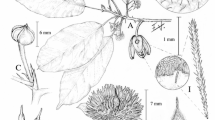Abstract
Origanum onites, widely used as a spice, grows wild in southern and southeastern Greece, especially in phryganic ecosystems. Like other woody plants of these ecosystems, it is characterized by seasonal dimorphism, an adaptation to face the summer drought. Its range in Greece is defined, and the features of its volatile oil are studied. It appears to be a fairly stable species, both from the morphological and chemical point of view. The high yields in volatile oil and high contents of carvacrol from all populations studied suggest the possibility of further profitable exploitation.
Similar content being viewed by others
Literature Cited
Buil, P., J. Garnero, G. Guichard, and Z. Konur. 1977. Sur quelques huiles essentielles en provenance de Turquie. Rivista Ital. EPPOS 59:379–384.
Calzolari, C., B. Stancher, and G. Pertoldi-Marletta. 1968.Origanum oils and their investigation by gas Chromatographie and infrared spectroscopic analysis. Analyst 93:311–318.
Cornu, A., and R. Massot. 1979. Compilation of mass spectral data. Heyden, London.
Granger, R., J. Passet, and R. Verdier. 1964. Le 7-terpinène précurseur du p-cymène dansThymus vulgaris. Compt. Rend. Hebd. Séances Acad. Sci. 258:5539–5541.
Greuter, W. 1979. The flora and phytogeography of Kastellorizo (Dhodhekanisos, Greece). I. An annotated catalogue of the vascular plant taxa. Willdenowia 8:531–611.
Halácsy, E. von. 1902. Conspectus florae Graecae 2:556. Engelmann, Leipzig.
Ietswaart, J. H. 1980. A taxonomic revision of the genusOriganum (Labiatae). Leiden Botanical Series. Vol. 4. Leiden University Press, The Hague.
—. 1982.Origanum L. Pages 297–313in P. H. Davis, ed., Flora of Turkey and the East Aegean Islands. Vol. 7. University Press, Edinburgh.
Jennings, W., and T. Shibamoto. 1980. Qualitative analysis of flavor and fragrance by glass capillary gas chromatography. Academic Press, New York.
Lawrence, B. M. 1984. The botanical and chemical aspects of Oregano. Perfumer and Flavorist 9:41–51.
Margaris, N. S. 1976. Structure and dynamics in a phryganic (East Mediterranean) ecosystem. J. Biogeogr. 3:249–259.
Rechinger, K. H. fil. 1943. Flora Aegaea. Akad. Wiss. Wien, Naturwiss. Kl., Denkschr. 105:532- 533.
Rhyu, H. Y. 1979. Gas Chromatographie characterization of Oregano and other selected spices of the Labiatae family. J. Food Sei. 44:1373–1378.
Scheffer, J. J. C., A. Looman, and A. Baerheim Svendsen. 1986. The essential oils of threeOriganum species grown in Turkey. Pages 151–156in E.-J. Brunke, ed., Progress in essential oil research. Walter de Gruyter and Co., Berlin.
Stenhagen, E., S. Abrahamson, and F. W. McLafferty. 1974. Registry of mass spectral data. Wiley-Interscience, New York.
Author information
Authors and Affiliations
Rights and permissions
About this article
Cite this article
Vokou, D., Kokkini, S. & BessiÈRe, JM. Origanum onites (Lamiaceae) in Greece: Distribution, volatile oil yield, and composition. Econ Bot 42, 407–412 (1988). https://doi.org/10.1007/BF02860163
Received:
Accepted:
Issue Date:
DOI: https://doi.org/10.1007/BF02860163




